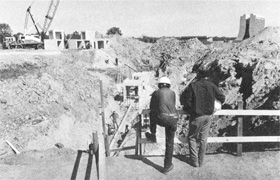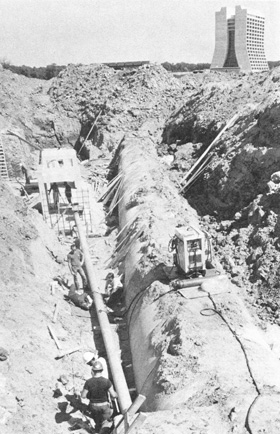Accelerator Upgrading, Part II
Previous week's Village Crier spotlighted the Accelerator Division's transfer hall extension. This week we look at another Accelerator project coinciding with a Laboratory maintenance and development shutdown (Aug. 15 - Sept. 12, 1977): the second stage of a three-phase project installing a reverse injection (RI) tunnel from the booster area to the Main Ring (MR).
The RI tunnel, according to Accelerator executive assistant Bruce Chrisman, will be used in colliding beam efforts. Colliding beam facilities are an integral part of Fermilab's Tevatron project, a new high energy physics range -- 1,000 GeV (1 TeV).
As in the transfer hall project, Chrisman said, RI work began before the accelerator was turned off. From the MR's F-2 service building west, an earth berm over the MR enclosure was removed and backfill excavated from both sides of the MR for a length of 240 feet. Remaining berm was removed after beam shutdown. Then an eight-inch diameter hole was bored through the 16-inch-thick MR wall for a 70-foot beam pipe extension.
Next, a base concrete slab -- 14 inches thick by 8 feet 8 inches wide and 130 feet long -- was constructed for the beam enclosure, access enclosure and access shaft. The slab will support 13 U-shaped tunnel elements and four comprising a labyrinth. Each element weighs 33,000 pounds and measures 10 feet long by six feet wide and seven feet high. After a power crane places the elements, connections will be welded and joints sealed.
This phase of the RI tunnel is a full scale tunnel that will be utilized for targeting an extracted beam of 80 GeV for anti-proton production. Beam pipe -- 10 feet of six-inch diameter sections and 60 feet of 12-inch diameter -- will be aligned, field welded ant tested by Fermilab personnel. The berm will be reconstructed over the MR and a berm will be constructed over the new MR enclosure to complete the project.
Phase 1 consisted of installing 20 feet of beam pipe from the booster and 80 feet of four-foot diameter sewer pipe enclosure east from the booster. Phase 3 will connect the first two sections with 1,100 feet of tunnel enclosure. Besides Chrisman, overseeing the reverse injection project are: Marv Warner, Architectural Services; Howard Casebolt, Accel. Safety; Tom Pawlak, project engineer; Mike Mascione, construction coordinator; and Bill Testing Alignment and Survey.


Reverse injection construction


